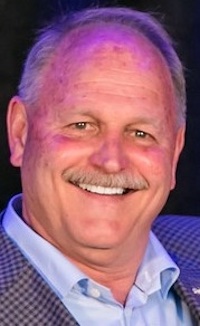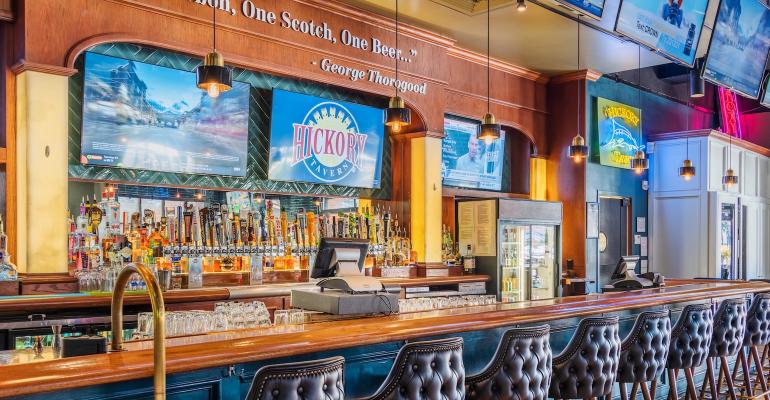Hickory Tavern, a 21-unit casual-dining concept in North Carolina and South Carolina, has debuted a streamlined menu and bar program and has its eyes on growth as CEO Mark Eason, formerly of Firebirds Wood Fired Grill, enters his ninth month with the brand.
Eason, who served as the CEO of Firebirds for 12 years, assumed the CEO title at Charlotte, N.C.-based Hickory Tavern last December and set about reinvigorating operations at the casual-dining brand, which first opened in in 1997.
 Eason said he was a frequent customer of Hickory Tavern when he was commuting to his Firebirds leadership role.
Eason said he was a frequent customer of Hickory Tavern when he was commuting to his Firebirds leadership role.
“I would pop in — it's right around the corner— and get wings and nachos, two of my favorite things,” Eason recalled. “I knew the Hickory Tavern brand pretty well.”
After Firebirds, Eason recalled, “I thought I'd retire and leave the industry. I found out very quickly that there's only so many episodes of ‘Gunsmoke’ and ‘Bonanza’ that you can watch. I'm just not that guy. I need to move around and be active.”
Brad Smith and Tommy Hager, co-founders of the concept, had sold an interest to New York City-based Rosser Capital in 2014, and were looking for a CEO. They tapped Eason.
In the past nine months, Eason has brought in consultants to re-work the menu, hiring Orlando, Fla.-based Shaping America’s Plate Inc., with registered dietician Pam Smith and executive chef Cliff Pleau, and the beverage program. New processes were incorporated, he said.
“We've touched everything on our menu pretty much except for the pretzel bites, which are a frozen product,” Eason said.
Cooking protocols for everything from chicken wings to hamburgers were shortened, he added.
Eason said the corporate team is ready to start looking at the size of Hickory Tavern units, which can range from 6,000 to 8,000 square feet.
“We want to set up the prototype to where we could we do this in a 5,500-square-foot building,” he said. “The smaller footprint still has a lot of space available to watch some TVs, to see some entertainment and have a good dining experience.” He recalled paring down Firebirds units from 6,500-6,700 square feet to 5,000-5,200 square feet and still maintaining sales.
The Hickory Tavern concept was founded in Hickory, N.C., from which it gets its name.
Earlier, Eason worked with Steak & Ale, Lone Star Steakhouse & Saloon and Bertucci's Brick Oven Pizzeria. In 2004, he joined Firebirds, where he has served as chief operating officer, president, and CEO, driving growth from four to 55 units. Firebirds was acquired in 2019 by J.H. Whitney Capital Partners.
Tammy Lucich, Hickory Tavern’s director of marketing and beverage services, said the casual-dining brand took advantage of the coronavirus pandemic to work on its technology offerings.
“Something that we did during COVID was actually evaluate the tech stack that wasn't currently in place,” she said. The company was able to incorporate new technologies into its Fan Club loyalty program, she added.
Casual dining offers many opportunities, Eason added.
“Brad and Tommy wanted a social gathering place, where people could come in and watch games, drink cold beers, eat wings, have great food,” he explained. “It's almost like having a polished-casual theme, because it's not just a sports bar. It's a sports bar with a little bit more elevated food.”
The Hickory Tavern brand also has a 24-year-year history that it can tap into, Eason said.
“I talked to guests who were kids and their parents were bringing them in,” Eason said. “Now these are our guests that are bringing their kids into the Tavern. it's kind of just been that family type place in North Carolina and South Carolina that people are used to.”
Staffing in the full-service concept continues to be a challenge, Eason added, but streamlining operations and removing steps has helped make the workforce easier to train.
The demographic remains much the same, tending toward males in the early 30s to 70s and 80s, Eason said.
“There's a wide range of people that come in at different times of the day,” he said, “whether it be a lunch at the happy hour time or for dinner or late-night snack."
Contact Ron Ruggless at [email protected]
Follow him on X: @RonRuggless

